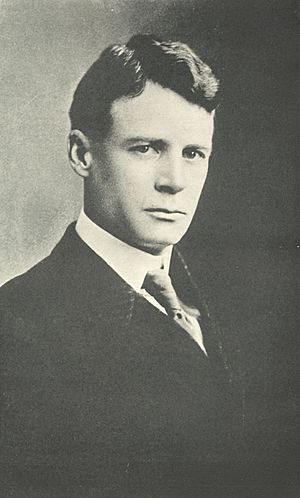Howard Taylor Ricketts facts for kids
Quick facts for kids
Howard Taylor Ricketts
|
|
|---|---|

Howard Taylor Ricketts
|
|
| Born | February 9, 1871 |
| Died | May 3, 1910 (aged 39) |
| Known for | blastomycosis, bacillus, typhus |
| Scientific career | |
| Fields | Bacteriology |
Howard Taylor Ricketts (February 9, 1871 – May 3, 1910) was an important American scientist. He studied diseases and how they spread. A whole group of tiny germs, called Rickettsiales, are named after him!
Contents
Early Life and Key Research
Howard Ricketts was born in Findlay, Ohio. Early in his career, he studied a fungal infection called blastomycosis at Northwestern University.
Discovering Rocky Mountain Spotted Fever
Later, Ricketts moved to Montana. He worked in the Bitterroot Valley and at the University of Chicago. Here, he focused on a serious illness called Rocky Mountain spotted fever. His research in Hamilton, Montana helped create the Rocky Mountain Laboratories.
While in Montana, Ricketts and his helper made a big discovery. They found that a specific type of tick carries the germ that causes Rocky Mountain spotted fever. This tick is called the Rocky Mountain wood tick (Dermacentor andersoni). Other ticks, like the American dog tick, can also carry it.
What are Rickettsia?
At first, scientists weren't sure what kind of germ caused the disease. Eventually, it was named Rickettsia, after Howard Ricketts. This was the first germ of its kind to be found. For many years, no one knew if Rickettsia were bacteria, viruses, or something in between. Now, we know they are special bacteria. They live inside the cells of other living things. The germ that causes Rocky Mountain spotted fever, Rickettsia rickettsii, is also named after him.
A Scientist's Dedication
Howard Ricketts was very dedicated to his research. He even injected himself with germs several times to study their effects. This showed how committed he was to understanding diseases.
In 1910, Ricketts became interested in a type of typhus disease. It was called tabardillo and was causing a big outbreak in Mexico City. He thought it might be similar to spotted fever. Just days after he found the organism he believed caused typhus, he sadly died from the disease himself. He was only 39 years old.
Lasting Legacy
Howard Ricketts left behind his wife, Myra Tubbs Ricketts, and their children. To honor his work, his family started an annual student research prize. It's called the Howard Taylor Ricketts Prize. It began in 1912 at the University of Chicago. Many important scientists have won this award over the years.
See also
 In Spanish: Howard Taylor Ricketts para niños
In Spanish: Howard Taylor Ricketts para niños

